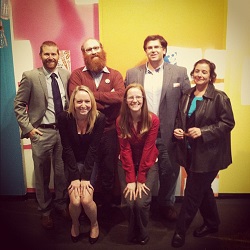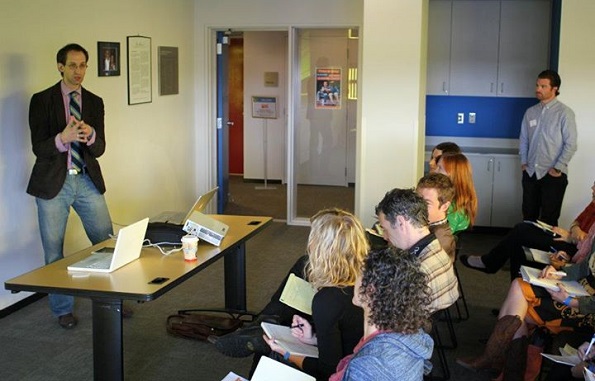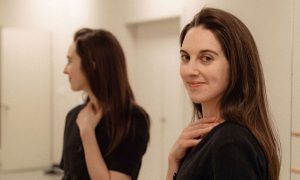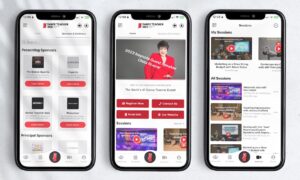By Stephanie Wolf of Dance Informa.
Talent aside, being an artist takes heart, perseverance and dedication.
Being a savvy businessperson takes assertiveness, know-how and a different type of diligence.
With a right-side versus left-side brain approach towards business, people are led to believe they can’t exhibit traits from both sides of the argument. Yet, cataloguing professionals into such polarizing personality types ultimately limits their ability to tap into their full capabilities throughout their career. Because professional art is a business and businesses thrive through creativity and innovation, there needs to be a certain amount of dialogue that focuses on meeting somewhere in the middle of the left-brain/right-brain conundrum—can’t we all just get along?
Springboard for the Arts’ Director of Professional Development Noah Keesecker says artists discount their abilities when it comes to creating a successful business around their art. He believes they often already possess the skills needed to be effective creatively and professionally, but lack the confidence or awareness. The professional development department is designed to unearth these talents and guide artists towards others with expertise about crucial components to cultivating a solid, legitimate career.
Work of Art
According to Keesecker, “the umbrella of professional development” encompasses specialized workshops and Springboard’s consultation program. The centerpiece of the programming, a 10-part workshop series, is called the Work of Art. Each workshop in the series is two and a half hours long and ranges from big-picture topics like career planning and time management to specific subjects like marketing, legal considerations, pricing your work, funding and social media. Keesecker calls the workshops “broad brushstrokes” of the issues, and says Springboard encourages people to either take the series as a complete curriculum or “a la carte.”
Keesecker says Springboard is “attentive to the needs around us,” and will continue to experiment with adding workshops, like panels on crowdfunding, as well as buying and leasing property, in response to the changing artistic landscape around them. “When we hear a lot of chatter around something, we say, ‘What can we build and where are the experts we can pull together?” says Keesecker.

Springboard staff and volunteer lawyers pose at the “Minnesota Lawyers for the Arts Pop-Up Clinic”. (L-R) Chase Buzzell, Alyssa Cassada, Andy Sturdevant, Sarah Howes, Kenneth Kunkle, Patty Zerlo.
Minnesota Lawyers for the Arts
Work of Art is only one component. Acknowledging the importance and sensitivity surrounding legal concerns in artistic businesses, Springboard offers Minnesota Lawyers for the Arts, a volunteer program that offers legal consultation and assistance for artists.
“Usually [artists] are afraid of the legal fees and the process of talking to a lawyer. So, we connect them with friendly and knowledgeable lawyers with a sort of low bono rate on services,” says Keesecker of the program. “It’s a very accessible environment to connect artists with these legal services that are really crucial in terms of formalizing the business.”
Legal workshops cover concerns like intellectual property as well as discipline-specific consulting. There is a roster of reputable attorneys that can speak on literary rights, grants, music licensing—which Keesecker calls a “large grey area for dancers in our community”—and more. For $20, artists can also attend Springboard legal clinics.
One-on-one consulting
After evaluating an artist’s needs, Keesecker says, he may refer artists with more specific issues to an Artistic Career Counselor. Springboard maintains a roster of consultants, which includes staff and contracted individuals, to work with artists in a one-on-one setting. Keesecker says he tries to respect the artist’s time—individualized consulting is $45 an hour, and Keesecker understands artists’ financial resources are limited—and matches them as discipline specific as possible.
Though he admits he does not come from a dance background, Keesecker is the on-hand dance counselor. As a composer and musician, he has worked with dancers and choreographers throughout the Twin Cities. “It’s one of those areas I am active in socially, in terms of my work,” he says. “So, I have a knowledge of the community here and access to a lot of the dance resources.”
He acknowledges it’s not ideal and hopes Springboard can build its capacity in the near future to employ a counselor with extensive experience in the dance industry. Keesecker adds that the organization would also like to expand the program to include a film specialist, building “deeper expertise in both areas.”
Customized development
With multiple components to the department, Keesecker says Springboard saw a need to create a complete education around professional development that was customizable and included multiple touch-points. The result is the Artist Field Guide, a five- or 10-part package that an artist builds him or herself.
“You buy a block of units and you can spend it on workshops or consultations and we sort of guide you in constructing that,” explains Keesecker. He says the format has become popular because it allows for a long-term outlook on the progression of their professional development and deepens the relationship between Springboard and the artist.
‘We do things locally, and we help make things happen nationally.’
While Springboard primarily serves the upper Midwest, Keesecker says the organization does not limit its overarching vision to this region. Through a partnership with the Tremaine Foundation, Springboard is in the process of extending its professional development curriculum to all areas of the nation.
In a similar vain to the CSA and Health Fair toolkits, Springboard is creating a toolkit to share with other arts community, so they can replicate their own professional development curriculum. This tactic has already been implemented with the University of Wisconsin-Madison and the Arts Counsel in Connecticut to great success.
Keesecker says Springboard is buzzing with excitement about this and hopes to make the toolkits available in late spring 2014. They will include revamped Work of Art educational materials, which can be adapted to be relevant and sustainable to the respective areas, as well as consultation opportunities with Springboard.
“We want to put it out into the world and see where it goes,” he says. “It’s like, ‘Go free little bird,’ and seeing how far it can fly.”
The dream…
Open up the possibility for other cities to develop their own Springboard and help foster creative, healthy lifestyles for local professional artists.
For more on Springboard’s professional development for artists programming, visit SpringboardfortheArts.org.
Photo (top): Noah Keesecker, Program Director, presents Funding Outside The Box to creative entrepreneurs at the Giant Steps conference in Minneapolis, MN.















